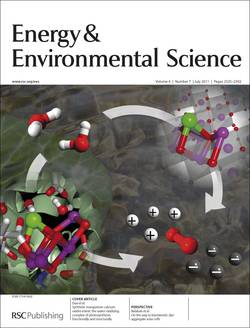Biocatalytic splitting of water
Due to its pivotal role in the photosynthetic formation of carbohydrates from H2O and CO2, light driven water oxidation at the Mn4Ca(μ-O)n complex of photosystem II (PSII) is of fundamental importance for biosphere and atmosphere. But it is not only the exceptional biological importance of water oxidation that renders this process a target of intense research. Irrespective whether H2 or carbon-based fuels are considered, any attractive route towards the 'ab-initio‘ synthesis of non-fossil fuels needs to involve water oxidation, that is, the usage of water as a source of electrons and protons. Presently, the performance of the biological water oxidation system is unsurpassed by any synthetic catalyst that operates without use of precious metals.
Mechanistically however, photosynthetic water oxidation is insufficiently understood. Our research aims at elucidating the biological water oxidation system at two levels: (i) the catalytic process itself and (ii) the structural as well as functional integration of the catalytic reactions into a complex protein environment. It comprises novel research activities specifically designed to establish a bridge from water oxidation in PSII to artificial catalysts for water oxidation based on transition metal oxides that resemble the biological catalyst functionally and structurally (see D3-3).
Research goals
- The question where and how the catalyst achieves the accumulation of four oxidising equivalents prior to O-O bond formation is intimately related to the still unsurpassed performance of the biological catalyst. Therefore, research activities will concentrate upon the electronic structure, that is, the orbital structure and occupancy, with explicit focus on the accumulation of four oxidising equivalents in the course of the catalytic cycle.
- Advanced EPR spectroscopy such as ENDOR on PSII crystals will extend previous experiments with respect to the assignment of oxidation states to specific Mn ions. The EPR approach will gain strength by the planned combination with DFT calculations using theoretical methods developed for tackling complex spin-coupling schemes.
- New approaches in X-ray spectroscopy involving high-resolution techniques for detection of X-ray emission spectra on partially oriented PSII samples will play an important role, complemented by polarised XAS at the Mn K-edge on PSII crystals.
- Crystallographic characterisation of the starting state for the self-assembly process in PSII will be approached by crystallising Mn-depleted PSII complexes and solving their structure, aiming at a resolution of 2.0 Å or better. These crystallographic studies will be complemented by spectroscopic experiments for tracking the multi-step assembly process in the time domain (UV/vis fluorometric methods, XAS, and FTIR).

